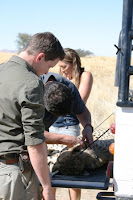The
30th of October marked a very important moment for the NCCC as it was
the day that saw our first cheetah released back to the wild. It was
made even more special as it was also the 40th cheetah N/a’an ku se has
released.
The
cat in question was Boris, the four year old male (as mentioned in the
previous blog) who was trapped and taken to N/a’an ku se’s wildlife
sanctuary in May 2011 after he had been hunting game repeatedly on a
small game farm in the Windhoek area.
One
of our most important tasks over the past few months has been to get
Boris back into good condition. This was because when he was first
released into the camp he was slightly under weight due to not eating
all of his food given to him at the wildlife sanctuary, which often
happens when a fully wild cheetah is placed in captivity and has to
adjust from eating live food to pieces of meat.
So
by late October Boris had spent almost 4 months in the camp and had
bulked up nicely, acclimatised to the area and had hunted several
springbok - he was fully ready to be put back where he belongs. A date
was set and our directors Dr Rudie and Marlice van Vuuren made the trip
to Solitaire accompanied by a handful of excited N/a’an ku se staff
members and a film crew from
Homebrew Films
who are filming for an ongoing documentary series about N/a’an ku se
for Animal Planet, the series will be called 'Wild Animal Orphans' and
will be aired on DSTV across the whole of Africa in March 2012.
The
day before their arrival Kate and I had successfully trapped Boris in a
trap cage. This was done by simply placing the cage in his favourite
area in the camp and placing a tasty looking zebra leg in the cage. This
meant that Boris would have to spend a night in the cage but darting
him on the day was simply not an option as he would run away or hide
deep in a bush when he saw us approach.
So
on the morning of the 30th the entourage drove to the camp where a very
confused Boris was waiting for us. Before releasing Boris we had to
change his VHF collar for a brand new
Sirtrack
GPS collar. Sirtrack is a New Zealand supplier of wildlife tracking
devices and they have generously donated a number of tracking collars to
N/a'an ku se for our conservation work as part of a new partnership
together. Boris' collar will send GPS points to a satellite every day
allowing us to
log onto our computer and download the data and monitor his movements.
Rudie
quickly prepared the dart gun and he and Marlice slowly approached the
cage. Marlice distracted Boris and Rudie made a successful shot and it
only took a few minutes for the drugs to take effect. With Boris fast
asleep we carefully removed him from the cage and placed him on the back
of one our Landrovers. The collar was quickly replaced and a couple of
very small wounds he had sustained in the cage were treated (hopefully
that will be the last trap cage Boris will ever see).
With
his new collar fitted Boris’ moment had arrived and we slowly drove
just outside the pen and into an open grass plain to the East. We found a
nice shady tree and placed the still sleeping Boris under it. Rudie
administered a quick acting reversal drug and then we all stood back.
Boris
slowly came around and after gazing in our direction with more
confusion he staggered to his feet and with the drugs still in his
system, wobbled away into the bush towards the mountains. It was an
amazing feeling watching him go free and as the reversal drug took hold
his movement quickly improved and he walked further away from us
experiencing life as a wild cheetah again.
The
next day we eagerly opened the Sirtrack software and downloaded the
first point sent to us from Boris’ collar. We were pleased to see that
Boris was still on our farm and not far from the release site.
Our
attention then turned to Spartacus who needed to be vasectomised. This
was necessary because as Spartacus will not be released we do not want
him mating with any of the females we will have in the camp. Everything
went very smoothly, Spartacus allowed us to approach and dart him
without any trouble and Rudie and Marlice carried out the procedure
quickly and efficiently. There was also a collar change for Spartacus as
we swapped his malfunctioning one for Boris’ old VHF collar. Kate and I
now hope on some occasions it wont take up to an hour to find him!
Spartacus woke up under a shady tree and as you would expect did not
look too pleased with us, so we left him to rest.
It
was a very exciting couple of days and it was great to hang out with
some of our N/a’an ku se colleagues who we don’t see that often. Rudie
and Marlice along with the film crew then started their journey further
south to one of N/a’an ku se’s other research sites at the
Sandfontein Nature and Game Reserve where three more cheetahs will be released.
The
following picture is a map of Boris’ movements during his first four
days back in the wild. His collar sends a GPS point once a day around
6:00am in the morning.
The
morning after his release Kate and I found his tracks along the eastern
side of the cheetah camp where the two females, Annie and Betty like to
hang out. He then moved southwards but not too far. Over the following
two days he moved towards the mountains where a large group of oryx were
seen, indicating that he may have been on the hunt. This morning
however we discovered that he really stretched his legs and has moved
off the farm and into an area by a river where we know there are also
lots of oryx springbok and zebra.
Its
fantastic knowing Boris is out there and we can’t wait to get to our
computers in the morning and see where he is! Boris will be the first of
hopefully many and the data we will gather about his movements is going
to be invaluable for the ongoing research of N/a’an ku se’s Carnivore
Research Project. We will of course keep you informed on Boris'
progress.
Before
I sign off, I'm sure you'll be pleased to know that Spartacus has fully
recovered from his ordeal and was treated to a tasty rack of Zebra ribs
yesterday :)
Photos by Deborah Binder
















